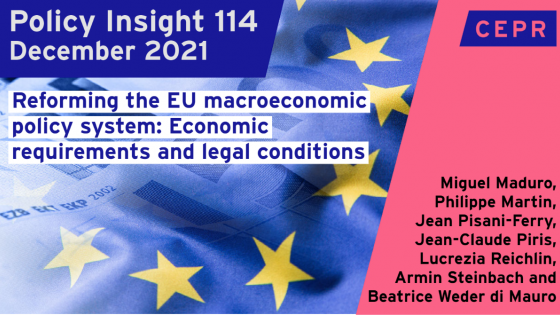After months of deliberations, the European Commission has finally published its proposal for a reform of the Stability and Growth Pact (SGP), which is briefly presented in Buti et al. (2022) and fully spelled out in European Commission (2022). The proposal, which member countries will examine, includes two major improvements and five main shortcomings.
The first improvement is to structure the procedure around the projected evolution of public debt. This is the right concept, as long argued by many economists (e.g. Martin et al. 2021, Wyplosz 2019). Fiscal discipline is fundamentally an intertemporal issue, not the year-after-year ‘deficit below 3%’ that fatally undermined all previous versions of the Pact. Debt must be sustainable, which means that it eventually converges toward a moderate level (say, 60% of GDP or less).
The second improvement is to differentiate countries according to their pre-existing debts. This naturally follows from the first improvement and avoids all countries being treated according to their annual deficits in the same way, applying the same rules to low- and high-debt countries. Even though the Commission has long recognised the need to move in this direction, and often did so in practice, the formal rule did not, which often led to bizarre contortions.
These conceptual breakthroughs, although obvious and long overdue, cannot be overappreciated. It is a pity, then, that the proposed implementation is marred by seriously flawed arrangements.
First, the debt path is to be established by the Commission using the well-established debt sustainability analysis (DSA). The DSA simply consists in using cumulated government budget constraint, an accounting identity, to describe the evolution of the debt over a specified horizon. The horizon must be long enough to approximate the formal definition of debt sustainability (technically, the transversality condition). The Commission proposes a four-year horizon, which can be extended to seven years under some conditions (more below), but the computation is based on a ten-year horizon. This is a reasonable compromise.
The path of the debt-to GDP-ratio is driven by three variables:
- the real interest rate of the debt service,
- the real income growth rate, and
- the deficit ratios, year after year.
Obviously, we know very little about the future evolution of the first two variables, so we must use forecasts, which are really just assumptions (Wyplosz 2011). The Commission proposes that it will be the one to make these assumptions. Since the debt path is highly sensitive to the assumptions, the Commission effectively decides when the debt is sustainable and when it is not.
The Commission proposes to conduct stochastic DSA to evaluate the plausibility of its assumptions, based on the past evolution of the real interest and growth rates. But will this work? Just think of the current situation: who can reasonably make any assumption for the next few years, and how does the past help in assessing their relevance? By taking this crucial step in its hands, the Commission would undermine the stated objective of giving back ownership to member countries.
Second, while the four-year horizon is an improvement, it remains unnecessarily short and stands to result in requesting countercyclical front-loading of budgetary adjustments – essentially asking members to cut spending in growth slowdowns. This feature plagued the previous versions of the SGP. Anticipating this criticism, the Commission envisions an extension to seven years, but under conditions. Strangely, these conditions do not address fiscal discipline proper. They require supply-side reforms and ‘good’ public investment. The logic, presumably, is that boosting the supply side helps with reducing the debt ratio. However, mixing up two different objectives – fiscal discipline and the quality of public action – blurs the purpose of the Pact.
For more than two decades, the SGP has failed to achieve fiscal discipline; extending its mission to boosting the supply side is unlikely to make its task simpler and more effective.
Third, once a debt path is agreed upon, each government must commit to make it happen. The budget constraint that drives the DSA calculations unambiguously identifies the primary budget balance as the relevant instrument. Surprisingly, the proposal requires that governments commit to “spending ceilings”. Could large tax cuts sneak under the radar and lead to large destabilising deficits? Of course not, for “public spending” is not what it is called. The proposed spending ceiling is in fact a “single operational indicator” meant to be simple and transparent. The indicator is defined as “net primary expenditure, i.e. expenditure net of discretionary revenue measures and excluding interest expenditure as well as cyclical unemployment expenditure” (European Commission 2022: 12). It means that tax cuts would count as spending increases. Beyond this misleading jargon, the indicator really is the cyclically adjusted primary balance that was introduced in a previous reform to allow for the operation of automatic stabilisers.
This was a good idea that turned out to be a bad one, because the cyclical adjustments proved to be impossible to measure with any acceptable precision. The Commission’s proposed solution merely consists in changing the name of the instrument, with minimal modifications. The new indicator is anything but simple and transparent, and it will lead to the exact same difficulties that torpedoed the use of the cyclically adjusted primary balance.
Fourth, in recent years member countries have set up national independent fiscal councils charged with monitoring their government budgets, from the preparation stage to final realisation. As shown by Beetsma et al. (2018), some of these councils have proven to be quite effective, others less so because they are not independent enough and/or insufficiently staffed. It is striking that the Commission completely ignores this evolution, arguably the most promising new tool to establish fiscal discipline. In addition, empowering national fiscal councils is a key path to establishing ownership. Of course, there must be some European oversight of national councils to guarantee their effectiveness. This why Beetsma et al. (2022) and Wyplosz (2013) propose that a revamped European fiscal policy council acts as the watchdog of national watchdogs, overseeing their independence, procedures and technical means. Of course, such an arrangement would reduce the central role that the Commission sets for itself, which effectively undermines national ownership.
Finally, from the start, enforcement has been the Achilles’ heel of the Stability and Growth Pact. As foreseen in Eichengreen and Wyplosz (1998), the reliance on financial sanctions was and remains illusory because, at the end of day, governments are unlikely to punish each other. Over the two decades since the pact has been in place, no sanction has ever been imposed and yet public debts have massively increased in many countries. The Commission is still pinning its hope on sanctions. Its idea is to have smaller sanctions to make them acceptable. This remains as illusory as it ever was. The solution is to rely on national fiscal policy councils by enhancing their roles and influence. The recent demise of UK Prime Minister Truss was largely due to the market reaction to her decision to produce a mini budget without consulting the UK’s highly reputed fiscal policy council, the Office for Budget Responsibility.
Concluding remarks
The Commission must be commended for having recognised that fiscal discipline is a long-run concept and that the proper gauge is the evolution of the debt ratio over a long horizon, to be assessed on a case-by-case basis. Unfortunately, like a chain’s robustness depends on every one of its links, the proposal suffers from fatal flows. Obviously, the Commission has to navigate through different and sometimes conflicting national views of fiscal discipline, an inherently political challenge. Taking national ownership seriously is the way to go, and that means decentralisation. It calls for a rigorous institutional design that combines strong and independent national fiscal policy councils with a similarly strong and independent European fiscal policy council. Quite possibly, decentralisation stands to reduce the role of the Commission.
National governments will now evaluate the proposal. Some will resent the impression of a power grab by the Commission, while others will approve of it in the hope of striking deals to escape the SGP’s strictures, as they have done in the past. Maybe that will ensure the proposal’s adoption; maybe that will lead to its wholesale rejection. Forging a proper Stability Growth Pact, which is a shared goal, now looks like another missed opportunity.
References
Beetsma, R, M Bordignon, X Debrun, M Szczurek and N Thygesen (2022), “Making the EU and national budgetary frameworks work together”, VoxEU.org, 13 September.
Buti, M, J Friis and R Torre (2022) “How to make the EU fiscal framework fit for the challenges of this decade”, VoxEU.org, 10 November.
Beestma, R, X Debrun, Y Fang, Y Kim, V Duarte Ledo, S Mbaye and X Zhank (2018), “Independent Fiscal Councils: Recent Trends and Performance”, IMF Working Paper No. 2018/068.
Debrun, X and W Reuter (2022), “Fiscal is local: EU standards for national fiscal frameworks”, VoxEU.org, 24 January.
Eichengreen, B and C. Wyplosz (1998) “The Stability Pact: Minor Nuisance, Major Diversion?”, Economic Policy 26: 67-113
European Commission (2022) “Communication on orientations for a reform of the EU economic governance framework”, COM(2022) 583 final
Martin, P, J-C Piris, J Pisani-Ferry, M Poiares Maduro, L Reichlin, A Steinbach and B Weder di Mauro (2021) “Reforming the EU macroeconomic policy system: Economic requirements and legal conditions”, VoxEU.org, 16 December.
Wyplosz, C (2011) “Debt Sustainability Assessment: Mission Impossible”, Review of Economics and Institutions 2(3): 1-37.
Wyplosz, C (2013) “Europe’s Quest for Fiscal Discipline”, European Economy Economic Papers 498.
Wyplosz, C (2019) “Fiscal Discipline in the Eurozone: Don’t Fix It, Change It”, Ifo-DICE Report II (17): 3-6.



